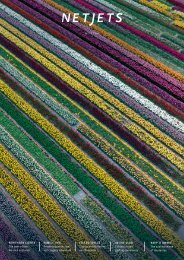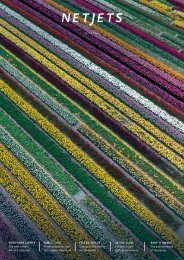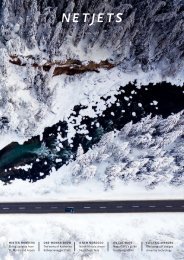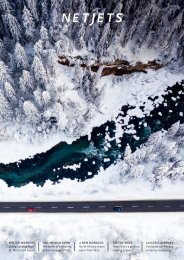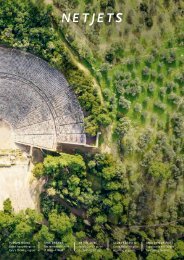Create successful ePaper yourself
Turn your PDF publications into a flip-book with our unique Google optimized e-Paper software.
artscape<br />
diverges most from more traditional mediums.<br />
Big-name artists like Marina Abramovic,<br />
Anish Kapoor, Olafur Eliasson and Antony<br />
Gormley have recently produced works that<br />
are freely accessible, not only at exhibitions but<br />
also online and in apps, so that anyone with a<br />
VR headset (or cardboard smartphone holder)<br />
can view the works for themselves.<br />
There is something almost revolutionary<br />
about this, and the man leading the<br />
democratic charge is Daniel Birnbaum, a<br />
longtime radical who shocked the art world<br />
last January when he left his eminent position<br />
directing the Moderna Museet in Stockholm<br />
to take the creative reins at London-based<br />
Acute Art, where most of the boldface names<br />
are producing their VR works. He has taken a<br />
serious gamble on VR as an art form, but he<br />
holds a remarkably long view of its potential:<br />
“There are some who say you could view art<br />
as a sort of service, not something you own<br />
or keep for yourself, but something you have<br />
access to—a little bit like Spotify or Netflix,”<br />
he says with a smile. “On the other hand,<br />
I’m not so sure. It’s a potential. There is<br />
something wrong if VR art is only collected<br />
like traditional art. There is potential for it to<br />
be distributed much more widely than that,<br />
so you don’t have to go to the Frieze Art Fair<br />
or to a big museum in Paris. You could be in a<br />
little suburb of Zagreb and see the exact same<br />
things. There is a sort of quasi-utopian aspect<br />
of this—that it could be everywhere—but I<br />
think it will take a while.”<br />
Birnbaum notes that some artists have<br />
shied away from the medium, not wanting to<br />
isolate the viewers so much, but even among<br />
those who have embraced it he sees a glimpse<br />
of that utopian spirit: “The people who want<br />
to try it are there because they are curious, not<br />
because they want to grow their audiences or<br />
make money.”<br />
It’s unusual in our age to see so much talk<br />
about art without foregrounding finance,<br />
which is why VR is so confounding—it is<br />
both democratic and cutting-edge, a pairing<br />
that has become exceptionally rare.<br />
But there is one place where this pairing<br />
is perfectly at home: Museums, which often<br />
have the same twin values. Even the Louvre,<br />
staid as it is, will offer the Mona Lisa VR<br />
experience to people not able to come to Paris<br />
during the exhibition on Viveport, the digital<br />
subscription service from HTC, the firm that<br />
makes the Vive headset.<br />
“Allowing visitors who may not be able<br />
to visit the exhibition in person to access<br />
this remarkable masterpiece by Leonardo<br />
da Vinci through our home version will give<br />
unprecedented access to da Vinci’s most<br />
celebrated painting,” says Victoria Chang,<br />
Director of Vive Arts at HTC.<br />
Chang’s pride in the democratization of<br />
the world’s most valuable painting is a far<br />
cry from the price-centric discussions of that<br />
other Leonardo masterwork, the Salvator<br />
Mundi, which sold for $450.3m in 2017. It<br />
might well be that in a few decades we will<br />
look back and see that VR’s biggest effect on<br />
the art world will not have been as a medium<br />
for artists, but as a means for making our<br />
artistic masterpieces more accessible to<br />
viewers across the globe.<br />
A starry sky in Olafur<br />
Eliasson’s Rainbow, 2017<br />
XXXXXXXXXXXXX<br />
70 NetJets










